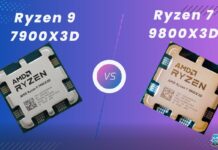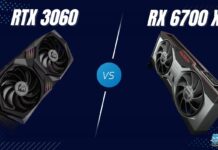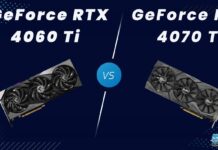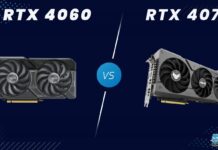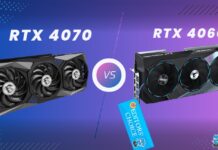AMD Ryzen 5 7600
Rated: 8.5/10
Intel Core i5-13500
Rated: 8.2/10
Pros And Cons
| CPU | Pros | Cons |
|---|---|---|
| Ryzen 5 7600 | ✅ Better gaming performance ✅ Overclocking unlocked | ❌ Worse thermals than the i5-13500 ❌ Require dual-channel memory for optimal performance |
| Core i5-13500 | ✅ Better for multi-threaded workloads ✅ Excellent thermals | ❌ Not overclockable ❌ Less efficient manufacturing process |
- The Ryzen 5 7600 outperforms the Core i5 13500 with an average FPS of 243.5 versus 237.2, and a 2.5% advantage in 1% lows, solidifying its superiority.
- The Ryzen 5 7600’s power management surpasses the Core i5 13500, boasting 17% higher energy efficiency, while the Core i5-13500 outperforms it by 13.8% in thermal management during tests.
- The Core i5 13500 costs $240, while the Ryzen 5 7600 costs $229, with a 6.5% price gap.
- If gaming performance and overclocking are your priorities, go for the Ryzen 5 7600; for multi-threaded tasks and better thermals, opt for the Intel Core i5-13500.
Comparison Table
| Specifications | Core i5-13500 | Ryzen 5 7600 |
|---|---|---|
| Architecture | Alder Lake S Refresh | Zen 4 |
| Overclocking | No | Yes |
| Max Core Frequency | 4.80 GHz | 5.10 GHz |
| Integrated GPU | Intel UHD Graphics 770 | AMD Radeon Graphics |
| GPU (Turbo) | 1.55 GHz | 2.20 GHz |
| GPU Technology | 10 nm | 5 nm |
| Memory Support | DDR4-3200, DDR5-4800 | DDR5-5200 |
Architectural Differences
- Core/Thread Counts: The Ryzen 5 7600 has 6 cores and 12threads, while the Intel Core i5-13500 offers 14 cores and 20 threads. The latter offers a significant edge in multi-threaded tasks with its performance and efficiency core combo.
- Socket: The i5-13500 uses the FCLGA1700 CPU socket, is compatible with the 12th-generation processors, and supports DDR4/DDR5 RAM. In contrast, the Ryzen 5 7600 adopts the AM5 socket for its 7000 series CPUs, introducing DDR5 support and shifting from a PGA to an LGA interface.
- Memory Support: The Ryzen 5 7600 exclusively supports DDR5 memory at a maximum speed of 5200 MT/s, while the i5-13500 retains DDR4 compatibility with a slightly lower maximum speed of 4800 MT/s.
- TDP: The i5-13500 has a higher PL2 rating of 154W compared to the Ryzen 5 7600’s 88W, impacting cooling options despite both having similar PL1 ratings of 65W.
We will compare the AMD Ryzen 5 7600 and the Intel Core i5-13500 head-to-head. From gaming benchmarks to power consumption, we provide insightful analysis to help you make an informed decision. Join us as we break it down, making it easier to choose.
Gaming Benchmarks
All these games in our Core i5-13500 vs Ryzen 7600 comparison were tested with 1080p Highsettings.
Testing Rig
- OS: Windows 10 Pro
- Motherboard 1: ASRock Z790 Taichi Lite Motherboard
- Motherboard 2: ASRock B650E PG-ITX WIFI Motherboard
- RAM: XPG Lancer RGB 32GB 7200MHz DDR5 Ram
- GPU: ZOTAC RTX 2070 Amp Extreme Edition
- CPU Cooler: Corsair ICUE H150I ELITE
- SSD: CORSAIR MP700 PRO 2TB Gen5 NVMe SSD
- PSU: ENERMAX REVOLUTION D.F. X 1050W
Player Unknown’s Battleground

- The Ryzen 5 7600 faired better in PUBG, having an average of about 264 FPS, while the Core i5-13500 managed to keep an average of 240 FPS.
- The 1% lows in PUBG were identical, 148 FPS.
Overwatch 2

- Looking at the results in Overwatch 2, the Ryzen 5 7600 had an average framerate of about 349 FPS, and the i5-13500 managed a frame rate of about 331 FPS.
- This time around, Intel scored much worse, the 1% lows, 241 fps compared to the Ryzen 7’s 269 fps.
COD: Modern Warfare II

- Modern Warfare II had the Ryzen 5 7600 output an average framerate of about 157 FPS, and the Intel i5-13500 managed a frameless at 156 FPS.
- Intel once again came slightly behind in the 1% lows, 118 FPS compared to the Ryzen 5’s 124 FPS.
Spider-Man Remastered

- Marvel’s Spider-Man showed the same trend, with the 7600 having an average of 218 FPS while the 13500 managed to get only 198 fps.
- Now, the i5 had better 1% lows, 105 FPS, compared to the Ryzen 5’s 98 FPS.
LostArk

- In LostArk, the Ryzen 5 7600 had an average FPS of about 395, whereas the i5-13500 had an average FPS of 337.
- The 1% lows were again higher on the 7600, 193 vs 186 on the i5-13500.
League Of Legends

- While playing the CPU-Intensicve game of League of Legends, the Ryzen 7 7600 had an average of about 252 FPS, whereas the i5-13500 had an average of 217 FPS.
- During my observation, 1% lows were lower on the i5, with 143 FPS vs the Ryzen 5’s 158 FPS.
Cyberpunk 2077

- Cyberpunk 2077 had the Ryzen 5 7600, giving an average of 158 FPS compared to the i5-13500’s 153 FPS average.
- The Ryzen had a 1% low score of 98 FPS, lower than the i5-13500’s score of 105 FPS.
Red Dead Redemption 2

- For RDR2, the Ryzen 5 7600 showed an average FPS of around 153 in RDR 2, whereas the i5-13500 showed an average FPS of 146.
- 1% lows were also higher on the Ryzen, with 107 FPS compared to the i5-13500’s 97 FPS.
Overall Gaming Performance
| Processor | Average FPS | 1% Lows |
|---|---|---|
| Ryzen 5 7600 | 📈 243.5 | 📉 142.5 |
| Intel i5-13500 | 📈 237.2 | 📉 132 |
| Winner: AMD Ryzen 5 7600 | ||
The Ryzen 5 7600 wins in gaming benchmarks with an average FPS of 243.5, while the Core i5 13500 trails at 237.2 FPS. The Ryzen 5 7600 maintains dominance, with 2.5% higher FPS performance and 142.5 FPS in 1% lows, compared to the Core i5 13500’s 132 FPS in 1% lows, establishing it as the superior choice.
Power Consumption
| Game | Ryzen 5 7600 (W) | Core i5-13500 (W) |
|---|---|---|
| PUBG | 44 | 43 |
| Overwatch 2 | 44 | 52 |
| COD: Modern Warfare II | 46 | 63 |
| Spider-Man Remastered | 49 | 65 |
| LostArk | 47 | 50 |
| League Of Legends | 32 | 35 |
| Cyberpunk 2077 | 69 | 77 |
| Red Dead Redemption 2 | 53 | 65 |
| Average Power Consumed | 48.25 W⚡️ | 58.25 W⚡️ |
| Winner: AMD Ryzen 5 7600 | ||
The Ryzen 5 7600 surpasses the Core i5-13500 with its impressive power management, consuming an average of 48.25W compared to the latter’s 58.25W. In energy efficiency, the Ryzen 5 7600 leads by a significant 17% margin over the Core i5-13500.
Temperatures
| Game | Ryzen 5 7600 (°C) | Core i5-13500 (°C) |
|---|---|---|
| PUBG | 57 | 52 |
| Overwatch 2 | 56 | 44 |
| COD: Modern Warfare II | 53 | 43 |
| Spider-Man Remastered | 65 | 53 |
| LostArk | 54 | 42 |
| League Of Legends | 45 | 42 |
| Cyberpunk 2077 | 71 | 58 |
| Red Dead Redemption 2 | 62 | 55 |
| Average Temperature | 57.7°C🌡️ | 49.7°C🌡️ |
| Winner: Intel Core i5-13500 | ||
During our tests, the Core i5-13500 stays cool at 49.7°C, surpassing the Ryzen 5 7600’s 57.7°C. It establishes its thermal management dominance, boasting a 13.8% lead and ensuring optimal temperature control for users.
Price And Availability
| CPU | MSRP | Current Price |
|---|---|---|
| Ryzen 5 7600 | 💲230 | 💲229 |
| Core i5-13500 | 💲250 | 💲245 |
| Price Difference | 8% | 6.5% |
The Core i5 13500 starts at $250, while the Ryzen 5 7600 starts at $230, an 8% difference. Currently, the Core i5 13500 is at $240, and the Ryzen 5 7600 is at $229, showing a 6.5% difference.
What Do We Recommend?
Ryzen 5 7600: Choose the Ryzen 5 7600 for superior gaming performance and overclocking capability. It surpasses the Intel Core i5-13500 with an average FPS of 243.5 compared to 237.2. Plus, you can overclock it for even better results. Note that it runs hotter than the i5-13500 and works best with dual-channel memory.
Intel Core i5-13500: If you prefer strong multi-threaded performance and great thermals, the Intel Core i5-13500 is a great choice. It offers 14 cores and 20 threads, excelling in multi-threaded tasks. Plus, it runs about 10 degrees cooler than the Ryzen 5 7600 on average.
If gaming performance and overclocking are your priorities, go for the Ryzen 5 7600; for multi-threaded tasks and better thermals, opt for the Intel Core i5-13500.
The Ryzen 5 7600 has 6 CPU cores, while the Intel i5-13500 features 14 (6 P-cores and 8 E-cores). Surprisingly, the Ryzen 5 7600 outperforms the i5-13500 in gaming workloads. Generally, you can expect 5-7% more performance after overclocking your CPU.Frequently Asked Questions
More From Ryzen 5 7600:
More From Core i5-13500:
Thank you! Please share your positive feedback. 🔋
How could we improve this post? Please Help us. 😔
[Comparisons Expert]
Abdemanaf is a skilled creative writer who has been honing his craft since 2011. While initially working in different fields, he found a passion for technology and has been exploring the tech world since early 2015. Over the years, he has developed an in-depth knowledge of the latest tech trends and product offerings by various companies.
Abdemanaf’s writing reflects his analytical mindset and ability to think critically. He has a knack for breaking down complex technical information into easily digestible pieces, making his articles engaging and accessible to readers from all backgrounds. In February 2022, he joined Tech4Gamers as a blog and product comparison writer, where he has been able to hone his skills further.
As a writer, Abdemanaf is dedicated to staying up-to-date with the latest technological advancements and trends, enabling him to provide readers with the most relevant and accurate information. He is always eager to learn more and is constantly seeking new challenges to improve his skills.
Get In Touch: manaf@tech4gamers.com


![CPU Comparison Template [NEW]](https://tech4gamers.com/wp-content/uploads/2023/05/CPU-Comparison-Template-NEW-1068x580.jpg)
